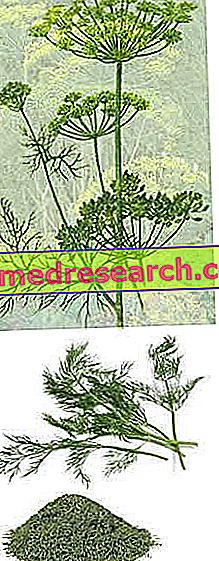Generality
Dill is an aromatic plant belonging to the Apiaceae family, Genus Anethum, Specie graveolens ; the binomial nomenclature of the dill is Anethum graveolens . Dill is a widely used culinary ingredient (for the respective organoleptic characteristics) and widely used in both the East and the Mediterranean.

Description
Dill is an annual herb that rarely exceeds a meter in height; it has a thin, striated stem, articulated in knots and with a circular section, which is articulated only in the highest part, where the umbel inflorescences arise (from mid-summer). From these there are numerous yellow flowers from which small brown fruits (such as achenes and therefore improperly called seeds) mature (at the end of summer). The leaves of the dill are thread-like and arranged in a spiral; they are concentrated in the lower part of the stem and branch off just above the underground portion (taproot and roots - very similar to that of chicory). WARNING! For an inexperienced eye, dill can be confused with wild fennel; however, the aroma and taste of the two herbaceous plants are not entirely overlapping.
Geographical distribution
The dill originates from the Boreal hemisphere, more precisely from the southwest Asia but, due to the favorable environment, it is also widespread in many southern European countries. To tell the truth, not all botanists share the hypothesis that dill may have oriental roots and some argue that its presence in the Mediterranean basin is not attributable to human importation.
Dill is an aromatic plant that prefers temperate climates and does not bear those that are excessively hot or excessively cold; for this reason, its presence on the Italian territory is greater in the hilly and low-mountain regions of the central-north (600-1000m) than in the "midday". Also in this case there is a certain ambiguity; it is not clear what the favorite climate of dill may be, due to its good acclimatization capacity.
The most suitable soil for dill cultivation is rich in calcium and silicon with a neutral, draining and low humidity pH.
Etymology
Since ancient times, dill was considered a medicinal plant and its applications ranged between: medicine, room aromatization, cooking, etc.
The nomenclature of the dill itself has extremely archaic roots. Anethum derives from the Greek word of "anise" (acquired from Egypt) and refers to possible therapeutic properties, while graveolens (Latin noun used in scientific classification) refers to the power of its aroma.
Uses of the dill
As anticipated, dill has always been considered a medicinal plant. Both the leaves and the fruits (seeds) can be used in infusion in the moderation of some symptoms or disorders such as: colic pain, digestive difficulties, loss of appetite, mild insomnia etc. Also according to popular medicine, dill can also be useful in increasing diuresis and fighting intestinal infestations.
In the past, dill was also considered a good aphrodisiac, a tonic for the body and the mind, a cure for epilepsy and even a good remedy against bad luck.
Nowadays, dill is considered a predominantly aromatic plant and useful in gastronomy, while phytotherapeutic applications are limited. The edible portion of the dill is made up of leaves and fruits. As far as the leaves are concerned, its use ranges from the seasoning of fishery products to the formulation of composite aromas for some meats and sauces (in India, dill is an essential constituent of pickled preserves). The seeds (oily) belong to some recipes for liqueurs and other spirits, and their chewing is a useful remedy against bad breath. Dill is used in Asia (especially in India), in some areas of Africa and the Middle East, and in Europe (especially in the North and East). Like all spices, it can be considered a natural preservative.
An essential oil is obtained from the seeds of the dill (2.5% content, while 8% is fat oil), very useful in the composition of soaps and some types of deodorant. Fruits and essential oil are used in the treatment of dyspeptic disorders, thanks to their stimulating properties (they promote the secretion of gastric juice), disinfectants (against fermentation processes) and at the same time spasmolytic (they relax the smooth muscles of the digestive organs). Among the phytotherapeutic uses of the dill there are: aerophagia, dyspepsia, hiccups, excessive intestinal fermentation (meteorism, flatulence, infectious diarrhea), nervous vomiting, intestinal colic of nervous origin and infantile colic.
The Commission E, the German committee of experts in charge of the evaluation of phytotherapeutic drugs, approves the dill for digestive disorders.
- To refresh the breath, it is useful to chew a teaspoon of dill seeds
- The infusions are prepared at concentrations close to 2.5%: 5 grams of crushed fruits (seeds) are immersed for 10-15 minutes in 200 ml of boiling water with a flame out. Filtration and consumption during the day follow (max 3 cups a day). Doses should be reduced, according to medical advice, in preparations intended for children with colic.
- For the use of commercial preparations, rely on the instructions provided by your doctor or on the packaging.
At therapeutic doses, dill is generally well tolerated and free of side effects, except in cases of individual hypersensitivity to one or more of its components. At high doses it can induce toxic effects.
Nutritional composition
Dill is an aromatic plant and its nutritional role in human nutrition is almost marginal. The dill uses a very high content of mineral salts and vitamins, although we recall that some electrolytes of vegetable origin (eg iron and calcium) do not boast a bioavailability similar to that of food of animal origin.



